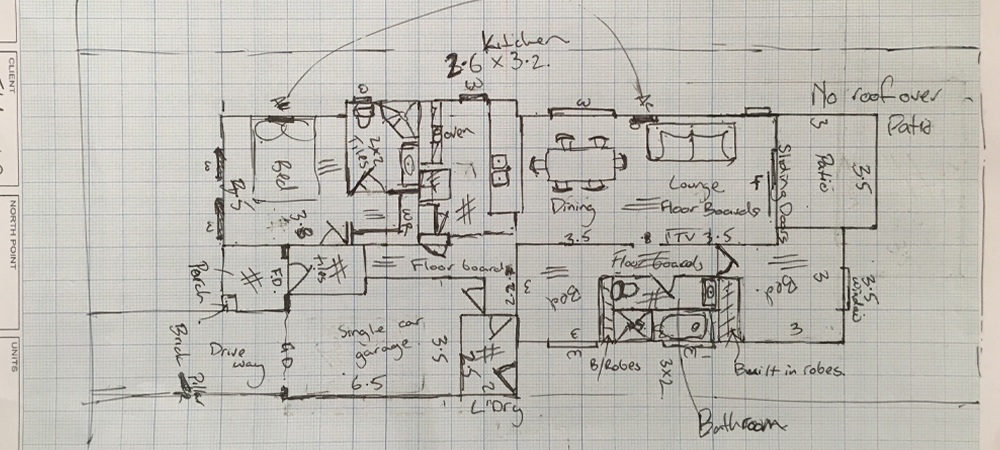SAVE MONEY BY DRAWING YOUR OWN FLOOR PLAN WITH THESE HANDY TIPS
It is more and more apparent that floor plans are becoming a necessity when listing a property. You want to find that edge to make your property stand out, one of the best ways to do this is to include a floor plan, giving buyers the opportunity to visualize the flow of the house.
In the past, you had to hire a specialist to draw your plans which is expensive and time-consuming. At BoxBrownie.com we are all about making real estate marketing easier for you, that is why we can turn your hand-drawn plans into a professional looking floor plan.
The first step in drawing floor plans is to find the originals, this way you have a base to work off and only need to make amendments if there have been renovations made. If you don’t have any plans, don’t worry, we can provide you with 2D to full-color 3D floor plans, all from your hand drawings!
Here is a list of the simple tools you need to get your plan underway:
- Laser measurer, or measuring tape
- Graph paper
- Pens, pencils– It is handy to have a few different colors on hand, to mark different areas
- Clipboard
If you need an accurate floor plan here are some handy tips for getting the best results:
Roughly Draw the Layout of The House
Drawing the basic layout of the house gives you a base to work from, this doesn’t need to be completely accurate. The part that needs to be accurate are the measurements. Start with the exterior of the house, laying out the shape of the building. Once you have done this, include the interior walls.
Measure Along the Baseboard from One Corner of the Room to The Other
It is important that you are measuring each room the same way. We recommend that you measure along the baseboard of the room, from one corner to the other. This needs to be done for every room and space, recording the measurements on your roughly drawn plan as you go.
Accurate Measurements
Take a minimum of two measurements (four is best) for each small room of the property and ensure you have numerous measurements for larger areas. For
With any split-level interior areas, garages or annexes, measure each section separately as if it was a separate level and mark accordingly on your sketch. If these areas have stairs, please clearly mark them down so the areas are identifiable.
Feel free to leave as many notes for our floor plan re-draw team to help explain your drawing. Clearly write them down in the spare area of your plan.
Measure Doorways and Entries
This is particularly important if there are doors that are different widths, such as bi-fold or sliding doors. You will also need to indicate on your floor plan the direction the door opens (with an arc). Also measure on your plans at what point on the wall the door is located, so that the final plans are accurate.
Window Size
Like the doors, you will also need to measure window size and at what point they sit on the wall. Include these measurements on your floor plans as well.
Measure Any Unique Features and Fittings
You need to include all features or fittings in the house. Ensure you measure the surrounding space and their position within the room. Symbols can be used to indicate what these features are (there are a lot of websites out there that list what each symbol is).
Key fixtures that need to be included in the plans:
- All appliances
- Kitchen and bathroom cabinets and counters.
- Sinks, toilets, tubs
and showers - Fireplaces
- Equipment such as furnaces, air conditioning units
and water tanks.
Switches and Power Points
We recommend including the locations of power points and switches. This will help designers position furniture and additional details on your floor plan.
Label Floor Surfaces
With many floor plans, you will have the option to display the type of flooring in different rooms. In each room clearly mark what flooring is there, such as tiles in the bathroom, carpet in bedrooms and hardwood flooring in the dining room.
Include Direction of the House
On the plans include an indication of north. This is something that you will want in the final plans as it helps to better understand the positioning of the house.
Name the Rooms
Make sure you name each room (eg. Master Bedroom, Kitchen) this includes closets and open spaces, such as entrances. This will make it easier for the editors to re-draw the plan.
Add Furniture
This is an option you can choose to include, but it isn’t essential. If you want our designers to place furniture in the floor plan accurately, you can hand draw in each room where specific furniture should sit. This will help potential buyers understand the size and layout of the room.
Creating your own floor plan can save you hundreds of dollars. Once you have set out all the details of your plan, just upload them to our floor plan edit tab and choose the kind of floor plan you want.
If you want more details on measuring floor plans
Keep an eye out for future posts on handy trips for getting your floor plans looking professional.
Check out the floor plans you can choose from here.
